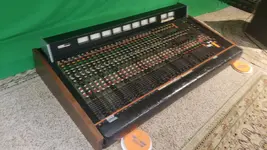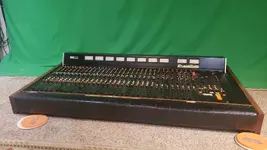Yes, don’t hear much about these tanks . And I’ve never seen one in person.
As a matter of fact, I’ve only even seen two videos on YouTube.
He tells me just the power supply is like carrying a Marshall head, and it took three guys to bring it in.
So I’m guessing it’s a beast!.
At this point it seems to be similar to an M520 in that it’s unbalanced RCAs.
Except it runs transformers and has 24 channels.,
I could be wrong but I’m thinking the M520 was a significant ‘upgrade’ and more compact. (Ownership bias maybe? )
Anyway when I make it over to his house, I’ll take lots of pics.
The Model 15 and it’s successor the M-16 were part of a different lineage than the M-500 consoles. That lineage included the Model 2 series, Model 3, and more identifiably the Model 5 series and it’s successor the M-35. Yes there are transformers but only on the MIC input. Everything else is transformerless. And yes everything up until the mid to later 1980s (with the M-1500/2500/3500/3700/5000 generation) had lots of RCA I/O. But the successive generation from the early Teac/“Tascam Series” consoles began with the M-30 and M-50, and then the M-500 series and M-300 series.
Yes the successive generation were more compact in terms of their topology, but one of the other huge differences was the departure from the individual plug-in channel modules found on the Model 5 series, M-35, Model 15 and M-16 (and to be fair the early Model 10 console is actually the predecessor to the Model 15 and also had individual plug-in modules)…to the 4-channel modules found on the M-50/M-500 series that require unplugging of a host of mini Molex connectors to remove the 4-channel module. This was a cost-cutting measure for sure and while it still made it easier to service than something with a one-piece dress panel to which all PCBs were mounted, or (blech) a horizontal monolithic PCB, it’s nothing like the early generation where there were no connectors to unplug, and then further disassembly to access one of the four PCBs in the module. The early generation stuff you flipped down the arm rest remove a couple screws and slide the single channel out for service…that’s on the Model 5 series and M-35…the motherboard is vertical at the back and the modules mate up with a push from the front. On the Model 15 (and M-16) I think the motherboard is horizontal and the modules push down to mate from the top. Also on the Model 15 (and M-16) each module has its backplane attached…jacks and all come out with the module whereas the backplane is fixed to the frame on the Model 5 series and M-35. Overall the Model 5, M-35, Model 15 and M-16 pound for pound have a bigger footprint and weigh much more than their later descendants…more steel, fancier frame, separator plates on the modules…and interesting side note, this is all one of a number of reasons I have such an affinity for my early 1980s 12 x 8 prototype Tascam console, the “M-__”…it is a one-of-a-kind missing link between the Model 15/M-16 generation and the M-50/M-500 series generation. Cosmetically it is M-50/M-500 series, which I think is a nice look, and the mic amp and other circuit features are M-50/M-500 series, but the channels are individual modules that plug in like the Model 15/M-16…the backplane of the M-__ looks a lot like a smaller Model 15 or M-16. But the M-__ is also something akin to a concept or show car where the manufacturer designs and builds it as a demonstration of possibilities…the M-__ has a kickass ultra-high headroom discrete line output driver on all the PGM and AUX buss outputs as well as the balanced master out…the M-50 two-channel balance amp output is the only place on a production model you’ll find this circuit. And the M-__ is loaded with electronic switching and per-channel definable global source switching…advanced features for the time…and all sorts of crazy SOLO and MUTE points as well as powerful monitoring features…switchable meter sourcing, and though there are only 12 input modules, there are actually a total of 36 inputs on those 12 modules that can all be accessed simultaneously and independently and mixed. And the circuit boards have all the traces and lands for all balanced line inputs and balanced outputs, and the backplane sub-chassis is pre-punched for XLR jacks. So it was built with the ability to be the first all balanced Tascam console. It was also the test bed for the EQ circuit that became the PE-40. So the M-__ missing link has some of the nice modular construction features of the earlier generation, the advanced audio circuitry and cosmetics of the next generation, but then a whole pile of advanced and powerful features that were mostly suspended before production due to, I assume cost, and/or it was all for marketing and R&D and never intended to go to market.
I’m sure the Model 15 will be fun to experience. It will be easy to work on. The two main things that really separate the Model 15 from more “professional” period consoles is the unbalanced I/O, lackluster output drivers (but not uncommon for the day on more budget consoles) and use of phenolic resin instead of glass fiber for the PCBs. But you’ll appreciate and enjoy the robust physical build and individual plug-in module construction. I believe I have some documentation somewhere for the Model 15…hopefully Merle’s still has the manual!





